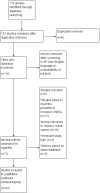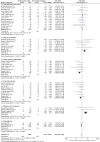Endovascular Coiling Versus Neurosurgical Clipping for Aneurysmal Subarachnoid Hemorrhage: A Systematic Review and Meta-analysis
- PMID: 31183299
- PMCID: PMC6538233
- DOI: 10.7759/cureus.4320
Endovascular Coiling Versus Neurosurgical Clipping for Aneurysmal Subarachnoid Hemorrhage: A Systematic Review and Meta-analysis
Abstract
Background Aneurysmal subarachnoid hemorrhage is a frequently devastating condition with a reported incidence of between 10 and 15 people per 100,000 in the United States. Currently, according to the best of our knowledge, there are not enough meta-analyses available in the medical literature of the last five years which compare the risks and benefits of endovascular coiling with neurosurgical clipping. Methods Twenty-two studies were selected out of the short-listed studies. The studies were selected on the basis of relevance to the topic, sample size, sampling technique, and randomization. Data were analyzed on Revman software. Results Mortality was found to be significantly higher in the endovascular coiling group (odds ratio (OR): 1.17; confidence interval (CI): 95%, 1.04, 1.32). Re-bleeding was significantly higher in endovascular coiling (OR: 2.87; CI: 95%, 1.67, 4.93). Post-procedure complications were significantly higher in neurosurgical clipping compared to endovascular coiling (OR: 0.36; CI: 95%, 0.24, 0.56). Neurosurgical clipping was a 3.82 times better surgical technique in terms of re-bleeding (Z = 3.82, p = 0.0001). Neurosurgical clipping is a better technique requiring fewer re-treatments compared to endovascular coiling (OR: 4.64; CI: 95%, 2.31, 9.29). Endovascular coiling was found to be a better technique as it requires less rehabilitation compared to neurosurgical clipping (OR: 0.75; CI: 95%, 0.64,0.87). Conclusion Neurosurgical clipping provides better results in terms of mortality, re-bleeding, and re-treatments. Endovascular coiling is a better surgical technique in terms of post-operative complications, favorable outcomes, and rehabilitation.
Keywords: aneurysm clip; coiling; endovascular; neurosurgery; sub arachnoid hemorrhage.
Conflict of interest statement
The authors have declared that no competing interests exist.
Figures
References
-
- Characteristics of nontraumatic subarachnoid hemorrhage in the United States in 2003. Shea AM, Reed SD, Curtis LH, Alexander MJ, Villani JJ, Schulman KA. Neurosurgery. 2007;61:1131–1138. - PubMed
-
- Diagnosis of subarachnoid hemorrhage. Edlow JA. Neurocrit Care. 2005;2:99–109. - PubMed
-
- International Subarachnoid Aneurysm Trial (ISAT) of neurosurgical clipping versus endovascular coiling in 2143 patients with ruptured intracranial aneurysms: a randomised trial. Molyneux A, Kerr R, Stratton I, et al. Lancet. 2002;360:1267–1274. - PubMed
-
- Procedural complications of endovascular treatment in patients with aneurysmal subarachnoid haemorrhage treated at a single centre. Alanen M, Pyysalo L, Jalava I, et al. Acta Neurochir. 2018;160:551–557. - PubMed
LinkOut - more resources
Full Text Sources



